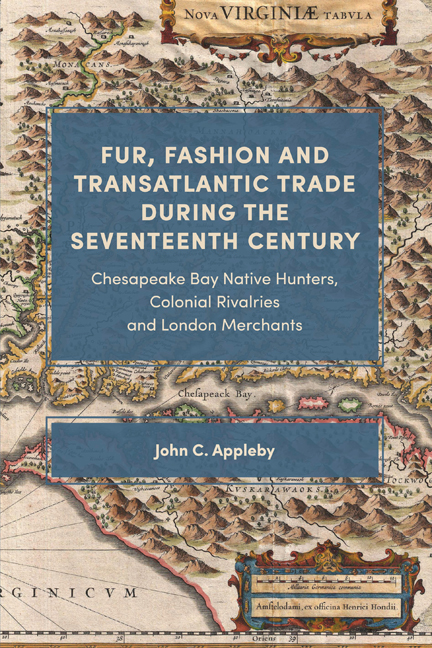 Fur, Fashion and Transatlantic Trade during the Seventeenth Century
Fur, Fashion and Transatlantic Trade during the Seventeenth Century Book contents
- Frontmatter
- Contents
- Acknowledgements
- A Note on Conventions
- Abbreviations
- Maps
- Introduction
- 1 Fur and Fashion: The Infrastructure of a New Trade
- 2 Commerce and Colonization: The Emergence of the Fur Trade in Chesapeake Bay
- 3 Trade and Rivalry: The Promise of Expansion and Innovation during the 1630s
- 4 Trade, Rivalry and Conflict during a ‘Time of Troubles’ from 1640 to 1660
- 5 Commercial Change and Conflict: Contrasting Experiences after 1650
- 6 Trade, Consumption and Industry: Transatlantic Constraints on the Bay Trade
- Conclusion
- Appendix
- Select Bibliography of Works Consulted
- Index
6 - Trade, Consumption and Industry: Transatlantic Constraints on the Bay Trade
Published online by Cambridge University Press: 15 December 2020
- Frontmatter
- Contents
- Acknowledgements
- A Note on Conventions
- Abbreviations
- Maps
- Introduction
- 1 Fur and Fashion: The Infrastructure of a New Trade
- 2 Commerce and Colonization: The Emergence of the Fur Trade in Chesapeake Bay
- 3 Trade and Rivalry: The Promise of Expansion and Innovation during the 1630s
- 4 Trade, Rivalry and Conflict during a ‘Time of Troubles’ from 1640 to 1660
- 5 Commercial Change and Conflict: Contrasting Experiences after 1650
- 6 Trade, Consumption and Industry: Transatlantic Constraints on the Bay Trade
- Conclusion
- Appendix
- Select Bibliography of Works Consulted
- Index
Summary
In November 1700 the Board of Trade in London received an alarming report that the fur trade of New York and Boston had ‘sunk to little or nothing, and the market is so low for beaver in England that ‘tis scarce worth the transporting’. The author, Richard Coote, first earl of Bellomont, governor of the province of New York, was concerned at the wider consequences of the fall in the price of beaver skins, from fourteen to five shillings per pound, in the London market. While the declining value of beaver discouraged the Iroquois, the main suppliers of fur to the colony, it also reduced the incentive for distant native groups to trade with the English. Playing on the threat from the French in Canada, Bellomont argued that New York was a frontier province where relations with the Indians had to be managed in the interests of the monarchy. Ignoring the situation at Boston, he requested the removal of customs duties on fur in New York and England. Early the following year, he urged the board to secure parliamentary support to encourage the fur trade. Drawing on the example of France, he appealed for legislation requiring all hatters to use a certain amount of beaver wool in the manufacture of headwear. Such intervention would ‘help the consumption of Beaver which at present is grown almost out of use in England, since Carolina hats have been so much and Beaver hats so little in fashion’. Although demand for the latter revived, Bellomont's concerns illuminate the state of the transatlantic fur trade at the close of the seventeenth century. Colonial networks on which commerce depended seemed to be under threat, not least as a result of changes in the supply of raw material. This included the opening up of a vast commercial zone awarded to the Hudson's Bay Company in 1670. As studies of the company demonstrate, the rapid growth of the northern fur trade, based on seemingly limitless supplies of thicker and more valuable pelts, created problems in the metropolitan market, which was one of the sources of the governor's alarm.
- Type
- Chapter
- Information
- Fur, Fashion and Transatlantic Trade during the Seventeenth CenturyChesapeake Bay Native Hunters, Colonial Rivalries and London Merchants, pp. 205 - 240Publisher: Boydell & BrewerPrint publication year: 2021


